Vietnamese fruit enjoys breakthroughs in demanding markets

Vietnamese fruit products have recently been granted licenses to make inroads into a number of the global market, opening up plenty of prospects that can ensure the sustainable export of the local fruit items.
According to the latest figures released by the Agro Processing and Market Development Authority under the Ministry of Agriculture and Development (MARD), the export value of Vietnam’s fruit and vegetables for 2019 was estimated to stand at US$3.74 billion, a fall of 1.9 per cent in comparison to 2018.
China remains the country’s largest export market for fruit and vegetables, holding more than 65 per cent of the total market share. In spite of this, the nation’s export of fruit and vegetables to the Chinese market has undergone a downward trend in recent times as the northern neighbour seeks to tighten exports coming in from unofficial channels.
As a result, some of the country’s major fruit and vegetable items have not yet been granted licensing to export to China through official channels, leading to the increase in domestic consumption and processing activities.
Most notably, the nation’s fruit and vegetable exports to other major markets have enjoyed robust growth, including to the United States with US$137.7 million, up 9.2 per cent, the Republic of Korea (RoK) with US$119.4 million, an increase of 14.2 per cent, and Japan with US$112.4 million, up 14.4 per cent.
Several fruit products with great potential for exports have so far penetrated almost all fastidious markets in the world, including strong growth markets such as the US, the Republic of Korea, Australia, Canada.
Despite these positives, there is an increasing threat from emerging regional rivals such as Cambodia exporting mangoes to the RoK whilst China seeks to expand its dragon fruit cultivation area.
The MARD noted that the Vietnamese fruit industry could face numerous challenges in export activities if the sector fails to ensure factors such as product quality, food hygiene and safety.
Moreover, farmers must be capable of producing goods on a large scale in order to meet the orders of importers, an issue that has remained a problem for the domestic fruit sector for several years, according to the MARD.
Related news
Tools

Phối trộn thức ăn chăn nuôi

Pha dung dịch thủy canh

Định mức cho tôm ăn

Phối trộn phân bón NPK

Xác định tỷ lệ tôm sống

Chuyển đổi đơn vị phân bón

Xác định công suất sục khí

Chuyển đổi đơn vị tôm

Tính diện tích nhà kính

Tính thể tích ao



 Fisheries industry focusing on solutions to comply with…
Fisheries industry focusing on solutions to comply with…  The first aquaculture testing center for free in…
The first aquaculture testing center for free in…